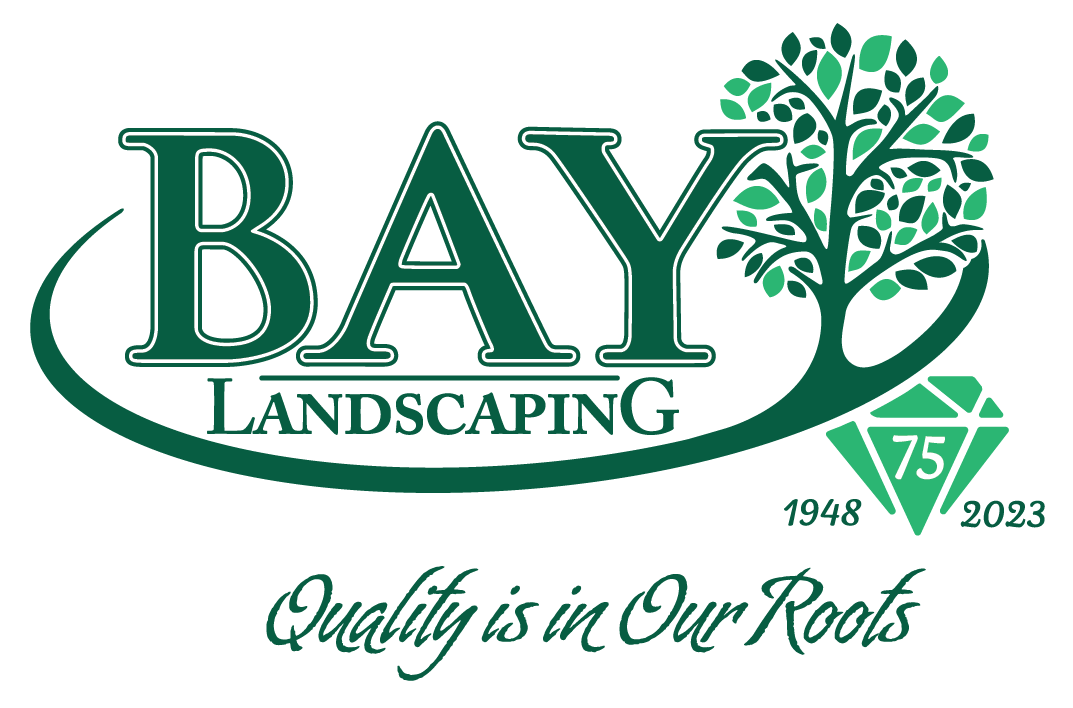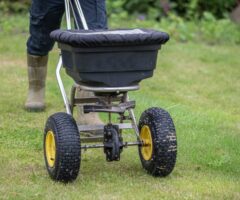Throughout the Mid-Michigan area, gardening enthusiasts and landscape professionals are discovering a revolutionary way to nurture their plants: self-watering planters. At Bay Landscaping, we’ve witnessed firsthand how these innovative planters are transforming both residential and commercial landscapes. Let’s delve into how self-watering planters can enhance your gardening experience, making it more rewarding and less labor-intensive.
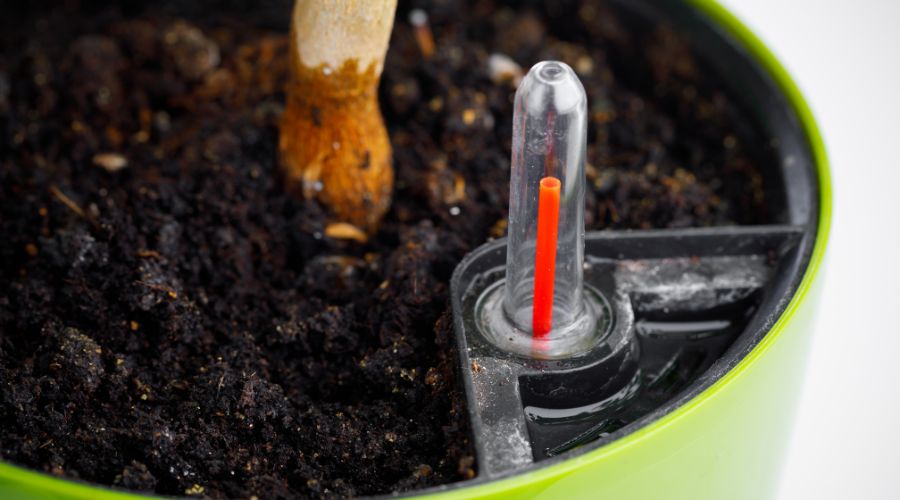 What Are Self-Watering Planters?
What Are Self-Watering Planters?
Self-watering planters are gardening containers equipped with a built-in system designed to keep soil consistently moist, providing a self-sustaining water supply to plants.
Key Components of Self-Watering Planters
- Water Reservoir: The foundation of a self-watering planter is its water reservoir, typically located at the bottom of the container. This reservoir holds a significant amount of water, which is drawn up into the soil as needed. The size of the reservoir varies with the planter’s size but is generally large enough to supply water for several days.
- Wicking System: Above the reservoir is a wicking system, usually made of a porous material. This system functions like a wick in a candle, drawing water upwards from the reservoir to the soil. The wicking material is in direct contact with both the water below and the soil above, ensuring a consistent transfer of moisture.
- Water Inlet: To fill the reservoir, self-watering planters typically have a water inlet. This can be a simple hole or a more sophisticated tube through which water is added. It allows for easy refilling of the reservoir without the need to displace the plant or soil.
- Overflow Mechanism: An overflow hole or spout is often part of the design. This feature ensures that the reservoir doesn’t get overfilled, which can lead to waterlogging of the roots. Excess water simply drains out through this overflow mechanism, maintaining an optimal level of moisture.
How Self-Watering Planters Work
The operation of self-watering planters is based on the principle of capillary action, where water moves through the wicking system from an area of high concentration (the reservoir) to an area of lower concentration (the dry soil). This action mimics natural groundwater movement, providing a steady supply of moisture directly to the plant roots.
When the soil dries out, it draws more water from the wick, maintaining a balance in soil moisture. This process continues until the water in the reservoir is depleted, at which point it can be refilled through the water inlet.
The beauty of this system lies in its ability to provide a consistent water supply tailored to the plant’s needs, reducing the risk of both under-watering and over-watering.
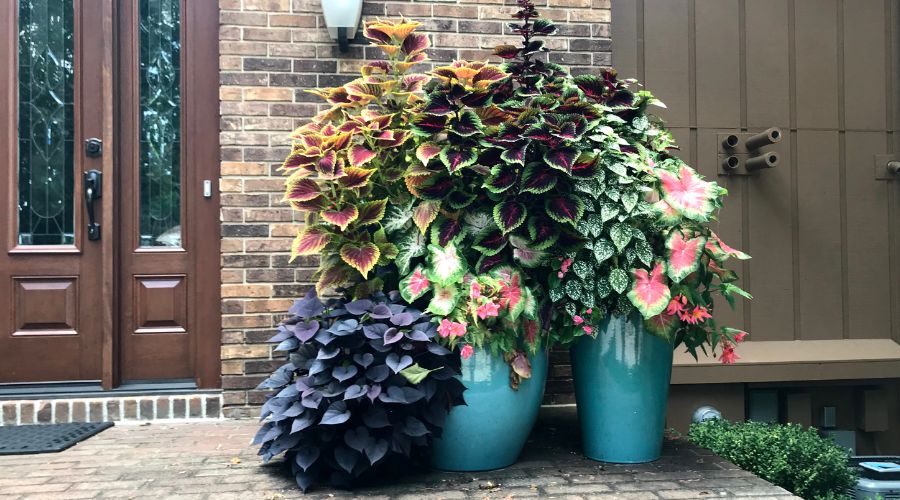 The Advantages of Using Self-Watering Planters
The Advantages of Using Self-Watering Planters
These ingenious devices offer a multitude of benefits that are particularly valuable in the dynamic Mid-Michigan climate. Here are just some of the advantages that make these planters a must-have for any gardening enthusiast or landscape professional.
Consistent Moisture for Plants
- Optimal Plant Growth: Self-watering planters maintain a balanced level of moisture, which is crucial for the healthy growth of plants. This consistent moisture availability ensures that plants have access to water as and when they need it, leading to healthier, more robust growth.
- Stress Reduction for Plants: Plants in traditional pots can experience stress due to fluctuating moisture levels. Self-watering planters eliminate this problem, providing a stable environment that promotes better root development and overall plant health.
Time and Effort Savings
- Reduced Watering Frequency: One of the most significant benefits is the reduction in the frequency of watering. Busy homeowners and commercial property managers will find this feature especially beneficial, as it frees up time that would otherwise be spent on daily watering.
- Ideal for Travel: These planters are also perfect for people who travel. The water reservoir can keep plants hydrated for several days, if not weeks, depending on the size of the planter and the plant’s water needs, ensuring that your plants remain healthy even in your absence.
Water Conservation
- Efficient Water Use: In an era where water conservation is increasingly important, self-watering planters stand out for their efficiency. They significantly reduce water waste by containing the water in a reservoir and only delivering what the plant needs, minimizing evaporation and runoff.
- Eco-Friendly Gardening: This efficient use of water aligns perfectly with environmentally conscious gardening practices, making self-watering planters an eco-friendly choice for sustainable landscapes.
Healthier Plants and Reduced Disease Risk
- Prevention of Diseases: Overhead watering, commonly used in traditional gardening, can lead to waterlogged soil and damp foliage, both of which are breeding grounds for fungal diseases and pests. Self-watering planters mitigate this risk by delivering water directly to the roots, keeping the foliage dry and reducing the likelihood of disease.
- Better Nutrient Uptake: The controlled watering mechanism also ensures that nutrients in the soil are not washed away through excessive watering. This results in better nutrient uptake, contributing to the overall health and vigor of the plants.
Visual Monitoring and Easy Maintenance
- Water Level Indicators: Many self-watering planters come equipped with water level indicators, making it easy to monitor and maintain the optimal water level. This feature is particularly useful for those new to gardening, as it takes the guesswork out of when to water.
- Simplified Plant Care Routine: The overall maintenance of self-watering planters is straightforward and user-friendly. This simplicity encourages more people to take up gardening, knowing that the daunting task of regular watering is efficiently managed.
Although these planters are low-maintenance, they shouldn’t be left outdoors when temperatures start dropping toward freezing. Learn how to winterize self-watering containers.
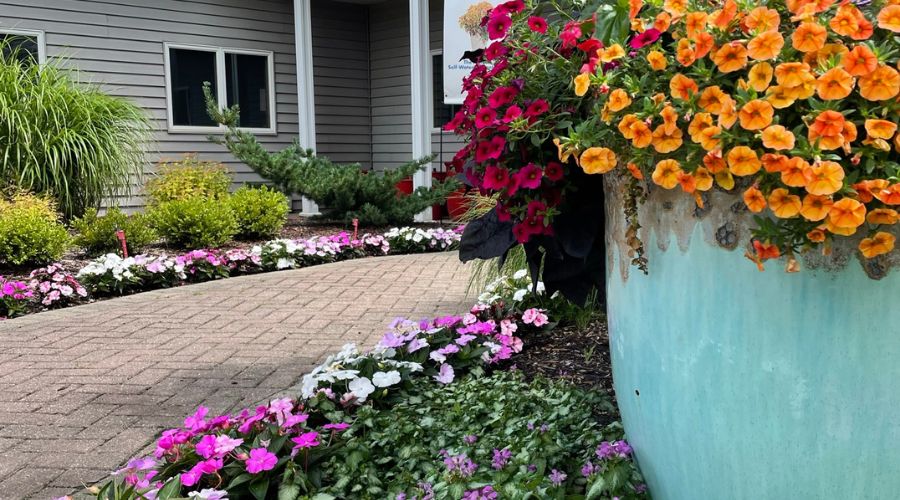 Choosing the Right Self-Watering Planter for You
Choosing the Right Self-Watering Planter for You
Selecting the right self-watering planter is crucial to meet both the aesthetic and functional needs of your garden space. Bay Landscaping offers a variety of these planters, each with unique features and benefits. Here are factors to consider and options available at Bay Landscaping to help you make the best choice:
Factors to Consider
- Size and Capacity: Consider the size of the plants you intend to grow. Larger plants with deeper roots require planters with a larger reservoir to ensure adequate water supply. For smaller plants or herbs, a compact planter might be more suitable.
- Material: Self-watering planters are available in various materials like plastic, ceramic, and resin. Plastic planters are lightweight and affordable, ceramic planters offer an elegant look, and resin types combine durability with style. Consider the climate of the Mid-Michigan area; some materials are better suited for outdoor use and can withstand varying weather conditions.
- Design and Aesthetics: Choose a planter that complements your home’s or business’s architectural style. Whether it’s a modern, sleek design or a more traditional, ornate one, the planter should align with your overall landscaping theme.
- Location and Mobility: Think about where you’ll place the planter. If you plan to move it frequently, a lighter planter that can be placed on casters might be ideal. For a stationary planter, weight and durability could be more important.
- Special Features: Some self-watering planters come with advanced features like water level indicators, which are incredibly useful for maintaining the correct water level without guesswork. Others might offer additional drainage options, which can be handy in managing excess water during heavy rains, a common occurrence in the Mid-Michigan area.
 Featured Products at Bay Landscaping
Featured Products at Bay Landscaping
Here at Bay Landscaping, we have a special fondness for two types of self-watering pots: AquaPots and EarthPlanters.
- AquaPots: These premium ceramic planters, known for their style and elegance, are perfect for those who value both functionality and aesthetics. AquaPots are particularly suited for decorative outdoor spaces and patios, offering a luxurious look with the convenience of self-watering. They are a Proven Winners® product, ensuring top-notch performance and beauty.
- EarthPlanters: These are best for those who prefer a more rugged, utilitarian design. Made from durable materials, they are ideal for larger outdoor areas and can withstand the elements. Their larger reservoirs cater well to bigger plants or shrubs and are often favored by commercial property owners for their environmental friendliness and practicality.
When choosing a self-watering planter, it’s important to balance functionality with personal preferences in style and design. At Bay Landscaping, we offer a range of options to cater to various needs and tastes. Whether you are a novice gardener or a seasoned landscaper, our selection of self-watering containers provides solutions that are not only practical but also enhance the beauty of your green spaces.
Ready to Enhance Your Landscape?
With a perfect blend of convenience, beauty, and efficiency, self-watering planters represent a smarter, more sustainable approach to plant care. Many local businesses and homeowners have seen remarkable improvements in their plant’s health and overall landscape aesthetics by switching to self-watering planters.
Visit Bay Landscaping in Bay City, MI today to find the perfect self-watering planter for your needs and join the ranks of satisfied gardeners who have discovered the joys of effortless and efficient plant care.
